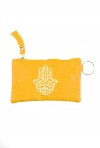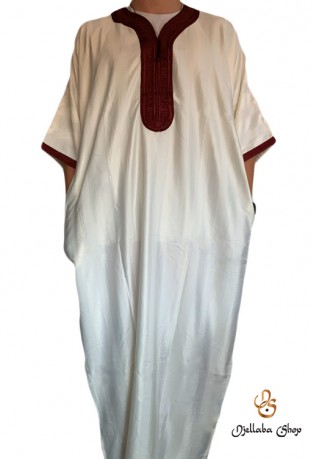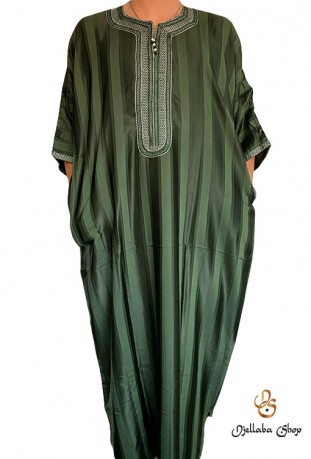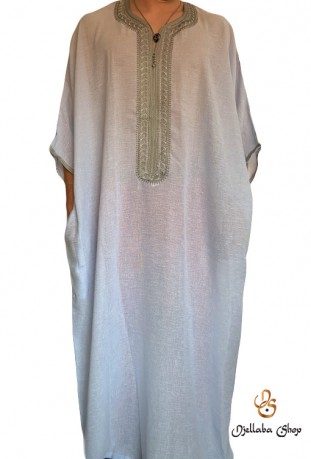-
 Français (French)
Français (French) -
 English (English)
English (English) -
 Español (Spanish)
Español (Spanish) -
 Deutsch (German)
Deutsch (German)
No products
Men's caftan There are 3 products.
It's like a djellaba without a headgear, and it's also superior to it in terms of the quality of the dresses and the abundance and brilliance of the silk embroidery, making it often worn at weddings and parties. Moroccan sultans wore the Moroccan caftan, but today this dress has become more associated with Moroccan women.
The Moroccan caftan
The...
It's like a djellaba without a headgear, and it's also superior to it in terms of the quality of the dresses and the abundance and brilliance of the silk embroidery, making it often worn at weddings and parties. Moroccan sultans wore the Moroccan caftan, but today this dress has become more associated with Moroccan women.
The Moroccan caftan
The Moroccan men's caftan is a traditional costume of Moroccan men and women , considered one of the oldest traditional clothes in the world belonging to Moroccans It dates back to the twelfth century at the time of the Almohad dynasty in Morocco. It is considered a symbol of nobility, elegance, heritage and identity in Morocco, especially on happy occasions such as weddings, henna and circumcision.
The origins of the Moroccan caftan date back to the twelfth century AD at the time of the Almohad dynasty, when the sultans of the Almohad dynasty sought a majestic outfit worthy of the status of Moroccan sultan. Where Fez was considered the first industrial city in the world in the year 600 AH corresponding to 1203 AD, because of the laboratories and factories of weaving clothes, of which the Moroccan caftan was manufactured. Leo Africanus says in his book Description of Africa about the city of Fez:In Fez, there are five hundred and twenty houses for weavers, which are many buildings with many layers and spacious rooms like palace halls. Each room includes a large number of linen weavers. There are also one hundred and fifty spinning mills for wool shorts, most of which are located next to the river. »
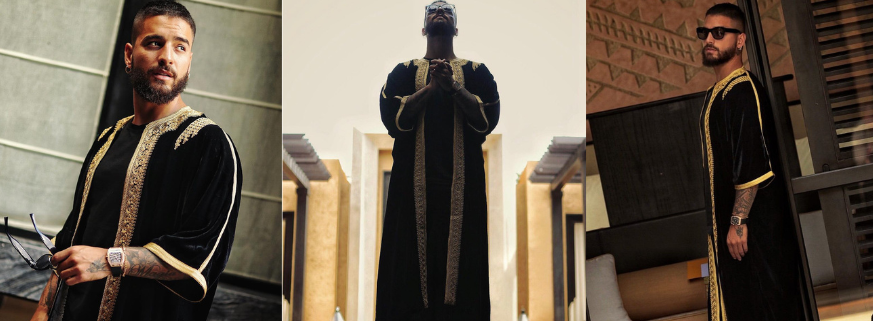
The 12th century Moroccan caftan was dark in color with short sleeves, on which men wore a piece of black or dark-colored wool called bernos. The front of the bronchi was shorter than the back to make it easier to walk or horseback riding. He had a cap or headgear that provided warmth in the winter. Also, the djellaba with babush was very popular with Moroccan menThe Moroccancaftan is the habit of the Merinid and Moroccan sultans since the fifteenth century
In the Merinid era in Morocco, the Moroccan caftan became the habit of the Moroccan sultans par excellence and during the fifteenth century AD, that is to say corresponding to the Wattassi era in Morocco, the Moroccan caftan was a feminine habit in Fez, as Leo the African describes it in his book " And the dress of women is beautiful, except that on hot days they are just a shirt. They bind it with a belt that is not free of ugliness, and in winter they wear wide-sleeved clothes sewn from the front, like men's clothes.
And it was the custom of the inhabitants of Fez to present the Moroccan caftans with the emblem of the bride in the Wattsian era, which Moroccans still want to preserve. Historian Ibrahim Harkat states: "It is customary for three to show up. caftans, three dresses, several shirts, a sherbella (Moroccan sandal) and decorative bedspreads and pillows, eight mattresses and four embroidered pillows placed next to the trays, as well as a rug, three bedspreads and other things. The woman's apparatus incurred exorbitant expenses for the average man that would soon impoverish him, but the bride's father would bear it exponentially. This indicates how much Moroccan caftan is linked to Moroccan culture.
Moroccan dress Al-Mansuriya inspired by the Moroccan caftan
In the Saadian era in Morocco, this dress will be known for the first time under the name of "Al - Mansuriya" in connection with the Moroccan sultan Al-Mansur Al-Dhahabi , who made especially for him in Fez, a piece of this dress and attributed to his name of a thick dress and the meta is a transparent Moroccan caftan. The historian Ahmed bin Khaled Al-Nasiri says in his book "The investigation of the news of the countries of the Far Maghreb". "The garment called Al-Mansuriyah, which is a piece of file, was not used before him, and it was the first to be invented and added to it, which is why it was said Al-Mansuriyyah. As historian Ibrahim Harkat mentioned in Sultan Saadi's robe:《Al-Mansur adopted a special robe, in which he inserted the caftan and Al-Mansuriyyah attributed to him, and he was the first to use Al-Mansuriyyah in his clothes, and this robe was adopted by kings and jurists after him.
The Moroccan caftan in the Alawite era
The kings and sultans of the Alawite state took care of their appearance and elegance, so the caftan was part of their clothes intended to appear on occasions and festivals that took place in the palace. The historian
of the Alawite state and the captain of its supervisors, "Mawlay Abd al-Rahman bin Zidan", mentions in his book that the Alawite sultans kept caftans made of the dress in wooden boxes and veneered.
The caftan of Moroccan women in the seventeenth century was a loose garment made of wool or velvet or any color and covered the whole body, but it was opened from the neck and this style had a collar or line at the waist, and the edges of the caftan were embroidered with gold threads. In addition, the caftan was tied with wide silk and gold belts that surrounded the waist. The Moroccan caftan was worn by the bride during the wedding ceremony in Morocco.
In the eighteenth century, the Moroccan women's caftan became the length of the ankle, open only on the side, and its shape changed into a long-sleeved shirt similar to a coat, usually made of wool, velvet or cotton, attached to a belt that the Moroccan woman puts around her waist.
During the nineteenth century, the traditional caftans of Moroccan women are now in museums. Some of them are in the museum of the Oudayas in Rabat and were seen by researchers in September 1977. All caftans were open at the front and held by numerous akkad buttons and small loops, and had side slots. In addition, they had a belt that went around the waist. The belt was made of brocade in the form of a silver or gold thread. Moroccan women wore a " charbella" special in velvet or Moroccan leather and embroidered with gold threads. Also, women Moroccan women used the veil or veil to cover their faces with this traditional caftan.
The modern Moroccan caftan
The traditional Moroccan caftan retains its place in Moroccan society on traditional occasions, such as the caftan al-Nata' al-Fassi and the henna caftan on henna night in Moroccan wedding rituals, and the caftan al - kharib, which is still worn with the fassi dress and the caftan of Hajj Omar, the basis of Tetouanism and Tetouanism. As for the modern Moroccan caftan, it is worn mostly in "dating" and family and religious occasions, because Moroccan women had more freedom to design their Moroccan caftan according to their taste. and modern styles, and in the middle are Al-Akkad, Al-Safifa and Al-Damamah This is considered the most important feature of the Moroccan caftan among other caftans. It is decorated with Moroccan motifs (Al-Nat' Fassi, Rabati motifs, Tetouan zigzag motifs, Fassi al-Hisab motifs, Chauni motifs ..) and the cultivation of precious stones, weights, garnets and the service of signs

